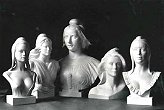Marianne
 The earliest representations of a woman wearing a Phrygian cap, an allegorical figure of Liberty and the
Republic, made their appearance at the time of the French Revolution.
The earliest representations of a woman wearing a Phrygian cap, an allegorical figure of Liberty and the
Republic, made their appearance at the time of the French Revolution.
 The earliest representations of a woman wearing a Phrygian cap, an allegorical figure of Liberty and the Republic, made
their appearance at the time of the French Revolution.
The earliest representations of a woman wearing a Phrygian cap, an allegorical figure of Liberty and the Republic, made
their appearance at the time of the French Revolution.
The origins of the name Marianne are uncertain. Marie-Anne was a very common first name in the 18th century, and she thus came to represent the people; the counter-revolutionaries used the name derisively when referring to the Republic.
 The Phrygian cap, the symbol of liberty, used to be worn by freed slaves in Greece and Rome. Mediterranean seamen
and convicts manning the galleys also wore a similar type of cap, and revolutionaries from the South of France are believed to have adopted the headgear.
The Phrygian cap, the symbol of liberty, used to be worn by freed slaves in Greece and Rome. Mediterranean seamen
and convicts manning the galleys also wore a similar type of cap, and revolutionaries from the South of France are believed to have adopted the headgear.
Under the Third Republic, statues, and especially busts, of Marianne began to proliferate, particularly in town halls. She was represented in several different manners, depending on whether the aim was to emphasize her revolutionary nature or her "wisdom." Occasionally, the Phrygian cap was felt to be too seditious, and was replaced by a diadem or a crown.
 In recent times, Marianne has taken on the aspect of famous actresses.
She also features on everyday articles such as postage stamps and coins.
In recent times, Marianne has taken on the aspect of famous actresses.
She also features on everyday articles such as postage stamps and coins.




